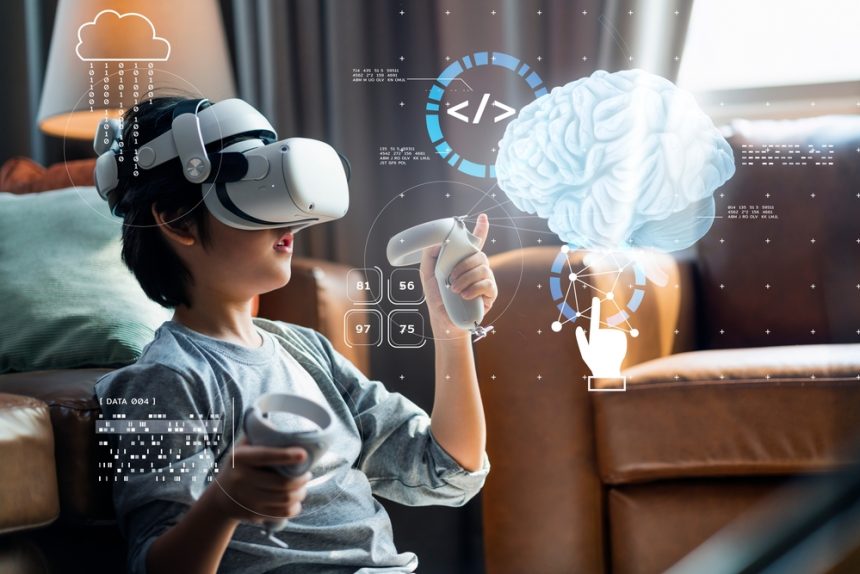In the past, we had yet to learn to create something even close to virtual reality and artificial intelligence technologies. After the technological breakthrough, we realized that virtual reality technology was perceived as something created only for games and entertainment and then demonized as an escape from the real world. Today, however, virtual reality is a real revolution in various spheres of life, including organizational productivity. VR represents a new way of communicating and utilizing digital information and connecting people with each other. With the ability to create realistic simulations, deliver comprehensive training, and facilitate collaboration, VR will become a key driver of productivity in today’s workplace.
How VR is used in workplace training and skills development.
One of the primary uses of VR to improve productivity is employee training and skill development. VR allows you to create realistic simulations of various dangerous or overly costly situations. Thus they appear risk-free, and by creating simulations of work tasks that, in reality, are expensive, dangerous, or impractical to replicate, there is a substantial increase in productivity. Equipment costs are reduced, and ability growth is accelerated due to the practice of the skill. And, of course, exploring situations in simulation is much safer. For example, companies can use VR to train workers in complex equipment operations; if they are doctors, nurses, or even military personnel, practice is critical, especially in preparation for such emergency responses or complex surgical procedures. This immersive reality training improves skill acquisition, retention, and transfer, ultimately improving productivity.
VR for organizational effectiveness.
VR can also help improve organizational efficiency by simplifying complex tasks and processes. By scheduling time in pm tools and using virtual reality as an object that helps you consider hypothetical situations closer, you can significantly improve your efficiency. For example, engineers and architects can use VR to visualize and improve their ideas before they are created, saving time and resources. Similarly, merchants can use VR to plan and improve their stores’ layout, increasing customer satisfaction and boosting sales. Additionally, VR can promote mental health in the workplace by offering a relaxing virtual environment to relieve stress, potentially reducing burnout and increasing overall productivity. Being transported to a pleasant time and taking a break from the hustle and bustle of work will make you feel much better about yourself. And as we know, your productivity is directly related to your satisfaction, which will be incredibly beneficial.
Remote work unification and communication through VR.
In the era of remote working and geographically distributed teams, VR technology is becoming a powerful tool to improve collaboration. Unlike traditional video conferencing, VR allows you to create a sense of “being there,” fostering stronger bonds and more effective teamwork. Employees can interact with each other and digital content in three dimensions, discussing ideas on a virtual whiteboard, manipulating 3D models, or exploring virtual prototypes. This starkly contrasts video conferencing, messengers, and phone calls. The level of communication at a remote job increases, skills improve, and the quality of work improves dramatically. This level of interaction can significantly increase productivity by streamlining decision-making and reducing the need to travel.
As VR technology continues to evolve, its potential to improve productivity is becoming increasingly apparent. Future VR applications may include virtual offices that allow for fully immersive work experiences, complex robotic operations using VR, and VR training programs integrated with artificial intelligence for personalized learning. However, to unlock the full potential of VR, organizations will have to overcome challenges such as ensuring access to the technology, user acceptance, and privacy and security in virtual spaces.
Conclusion.
In conclusion, virtual reality has ushered in a period of transformational prospects for enhancing productivity and organization. This cutting-edge technology, previously only used in games and entertainment, has been repurposed and refined for real-world applications, challenging preconceived notions about workplace communication, training, and operational efficiency.
VR’s immersive and interactive features are a crucial advantage and significantly impact skill development and professional training. VR helps workers to practice and refine their abilities, increasing their competence, confidence, and safety by producing realistic, risk-free simulations. This talent is essential in fields like healthcare and manufacturing, where high-stakes scenarios are common. It encourages quick learning, reduces possible risks, and improves overall job quality, considerably increasing productivity. Also remarkable is VR’s ability to improve organizational effectiveness. By enabling the depiction of complicated activities and fictitious scenarios, it promotes simplified decision-making and process improvement. Retailers may plan their store layouts to provide the best customer service, architects and engineers can perfect their plans before construction, and businesses can establish tranquil virtual workplaces to support mental wellness. These uses highlight virtual reality’s varied contributions to increasing output and fostering a healthier, more balanced workplace.
VR stands out as a powerful tool for collaboration and communication in the modern digital era, characterized by remote working and scattered teams. It transcends traditional media by creating a sense of co-presence, permitting three-dimensional interaction, and aiding the investigation of virtual prototypes. This innovative collaboration method boosts output and fosters more solid, enduring business ties. Future developments in VR technology promise to open up even more opportunities for increasing productivity. In the future are ideas like totally immersive virtual workplaces, intricate VR-assisted procedures, and AI-integrated training programs. But as we welcome these developments, it’s critical that we also address their underlying problems, such as providing equal access to VR technology, encouraging user adoption, and respecting privacy and security standards in virtual environments.
A fundamental change in how we view and interact with our working surroundings has been affected by virtual reality. Not only is it a technological advance, but it also acts as a potent catalyst, enabling previously unheard-of levels of production and organizational effectiveness. As we make our way through this exciting environment, it’s critical to safely, carefully, and inclusively leverage the power of VR to build innovative, creative, engaging, and employee-friendly workplaces.














